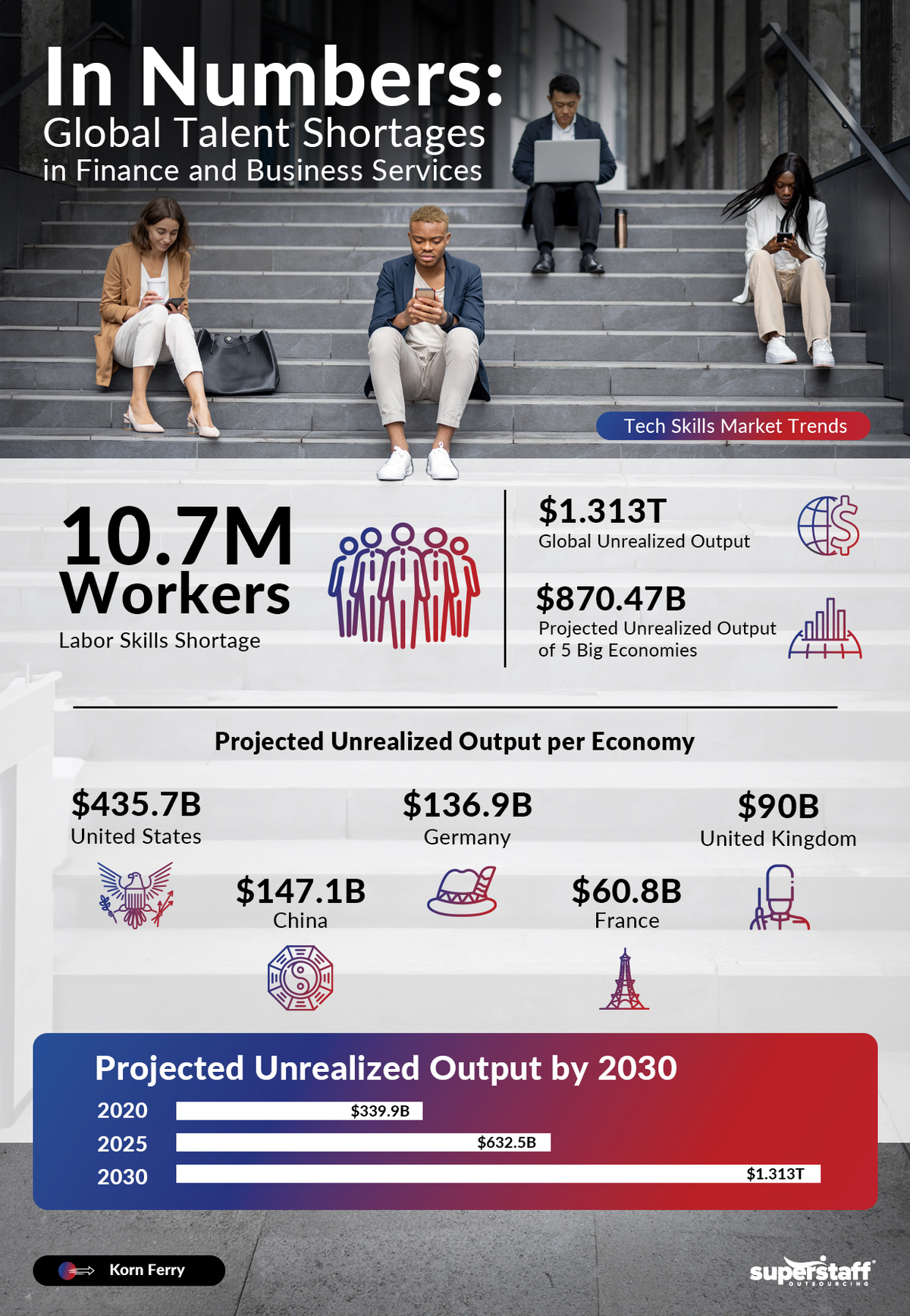
As decision-makers, you’re confronting an unparalleled talent shortage that has the potential to redefine the global economic terrain. This gap could result in an astonishing $8.452 trillion in unrealized annual revenues by 2030 — equivalent to the combined GDP of financial giants like Germany and Japan. As we rapidly approach this pivotal moment, grasping the ramifications of the global talent shortage is a must.
In this in-depth blog, we’ll dissect the economic impact of this talent deficit, examine regional perspectives, and explore strategies to mitigate these challenges. Discover how your business can navigate this crisis and develop sustainable solutions for a thriving future.
Trillions at Stake: Economic Impact of the Global Talent Shortage
Unrealized Income Globally
By 2030, you may find yourselves among leaders facing a daunting talent shortage of 85.2 million workers, exceeding the entire population of Germany. This scarcity mainly affects the critical domain of highly skilled workers — individuals essential for driving innovation and economic growth.
Korn Ferry’s analysis of 20 nations indicates that this deficit could amount to 21% of their highly skilled workforce, intensifying the significant disparity between demand and supply.
As for the financial consequences? Brace yourselves for trillions in unrealized output over the next decade:
- 2020: $2.1 trillion (3% of global GDP)
- 2025: $3.8 trillion (6% of global GDP)
- 2030: $8.5 trillion (11% of global GDP)
Regional Perspectives: The United States and Europe
The US, often regarded as a hub of innovation and enterprise, is not immune to this crisis. By 2030, labor shortages could cause an estimated revenue loss of $1.748 trillion.
Similarly, the situation warrants attention in Europe. Germany, recognized as the continent’s economic powerhouse, could face a potential deficit of 4.9 million workers by 2030, posing risks to the nation’s industrial base and financial stability.
The United Kingdom also contends with a similar challenge, with nearly $90 billion in unrealized output projected by 2030.
The Broader Implications
In the face of the global talent shortage, you’re confronted with more than just numbers; it’s a significant threat to future economic stability and growth. Economies worldwide will struggle to maintain their current paths without sufficient talent to propel innovation, productivity, and efficiency.
Businesses spanning various sectors will encounter heightened competition for a diminishing pool of skilled workers, resulting in wage escalation and possibly increased costs for goods and services. Consequently, this could impede economic growth, hamper innovation, and diminish global competitiveness.
Unrealized Income in the Financial Services Sector
Meanwhile, the financial and business services sector is also at a critical juncture. The projected talent shortage by 2030 threatens to stall economic growth and innovation, with far-reaching consequences for global markets.
Financial and business services are major growth drivers for developed and developing economies. In nations like the US and the United Kingdom, this sector constitutes roughly a third of the economy, while in Germany, it represents almost a quarter.
Financial services drive 23% of the United Arab Emirates’ economy, and in China, this sector is projected to contribute 17% to the national economy by 2030. Despite its critical importance, the sector is facing a severe talent shortage.
Korn Ferry projects a deficit of 10.7 million workers by 2030, equivalent to more than 45 times the global workforce of HSBC Bank. The financial implications of this shortage are staggering. Here’s a breakdown of the projected unrealized output due to labor deficits in financial and business services:
- 2020: $339.9 billion
- 2025: $632.5 billion
- 2030: $1.313 trillion
Due to talent shortages, markets could miss out on more than 16% of the projected global unrealized revenue by 2030.
Regional Perspectives: Top Financial Centers
The world’s top five financial centers — the US, China, United Kingdom, Germany, and France — are poised to bear the brunt of this crisis, potentially losing $870.47 billion in unrealized revenue by 2030. The United States, as the largest single contributor to this shortfall, could see a revenue loss of $435.24 billion, equivalent to 1.5% of its projected 2030 economy.
In Europe, financial hubs like the UK and Germany also face dire prospects. The UK is looking at a skills shortage that could equate to a fifth of its sector workforce by 2030. Germany, similarly, faces a challenge that could undermine its position as a leading financial center in Europe.
Japan, the world’s sixth-largest financial center, is also at risk. Its anticipated unrealized output of $113.62 billion in 2030 is more than 18% of the sector’s potential value.
Breaking Down the Numbers: Economic Impact Per Country
Here is a closer look at the expected revenue losses for the top financial centers:
- United States: $435.24 billion
- China: $44.45 billion
- United Kingdom: Skills shortage equivalent to 20% of sector workforce
- Germany: Significant shortfalls impacting global financial standing
The Knowledge Economy: A Critical Driver
Financial and business services dominate the knowledge economy, which is crucial for the economic advancement of both developed and developing markets. The sector’s contribution is particularly pronounced in countries with advanced economies, underscoring the potential damage that the business and financial services talent shortage could inflict — not just on individual businesses but on national economies as a whole.

Unrealized Income in Technology, Media, and Telecommunications (TMT) Sector
The technology, media, and telecommunications (TMT) sector is the beating heart of the global economy, fueling digital innovation and driving economic growth. However, this vital sector is on the brink of a shortage that threatens to derail its momentum. By 2030, the TMT sector could be short by 4.3 million workers, leading to a staggering $449.70 billion in unrealized output. This impending crisis demands immediate and strategic action to ensure the continued advancement of the digital revolution.
Here’s a quick glance at the projected unrealized output due to labor deficits over the next decade:
- 2020: $112.2 billion
- 2025: $213.5 billion
- 2030: $449.7 billion
The tech talent shortage is a formidable challenge that could stymie technological progress and economic contributions. As we approach 2030, the crisis underscores the pressing need for a comprehensive strategy to cultivate and attract the talent necessary to sustain growth and innovation.
Regional Perspectives: Key Markets at Risk
The talent shortage will have varying impacts across different regions, with some of the world’s leading technology markets facing significant losses:
- United States: As the current global leader in technology, the U.S. stands to lose $162.25 billion by 2030 due to sector skills shortages.
- China: Despite its quest to become a world-leading tech center, China could face a revenue loss of $44.45 billion by 2030, undermining its technological ambitions.
- Japan: With a projected shortfall of more than 500,000 Level A workers by 2030, Japan’s top-5 global tech market position is at risk.
- United Kingdom: The UK could fail to realize almost 9% of its TMT sector’s potential revenue by 2030 due to skills shortages, impacting its competitive edge in the global market.
What’s Fueling the Global Talent Shortages
Aging Workforce
The global talent shortage in 2024 is primarily driven by an aging workforce, creating a massive ripple effect across industries and economies. In 2020, there were 727 million people aged 65 and older worldwide. Fast-forward to 2050 and this number is expected to double.
The aging workforce is like a ticking time bomb for the global economy. As a generation of workers retires, businesses struggle to find replacements. This dramatic demographic shift means fewer working-age individuals would be able to fill critical roles, leading to a significant shortage of qualified workers.
- Decline in the Working-Age Population: Fewer working-age individuals result in a shortage of qualified workers, higher labor costs, reduced productivity, and delayed business expansion.
- Increase in Health Care Costs: Aging populations require more healthcare services, leading to higher healthcare spending. This sector also faces labor shortages, making it harder to meet the needs of older adults.
- Increase in Dependency Ratio: A smaller pool of workers must support larger older populations, straining public finances and social safety nets due to lower tax revenue and higher spending on pensions and healthcare.
- Changes to the Economy: Economies with older populations have different demand drivers, such as an increased need for healthcare and retirement services.
Countries with the highest proportions of older adults include Japan, Italy, and Finland.
Wealth Increase
Another fascinating trend is emerging in the global economy: a significant increase in personal wealth, which, while seemingly beneficial, may also contribute to the burgeoning labor shortage. By 2027, international wealth is projected to rise by 38%, driven largely by the booming economies of emerging markets.
This is echoed by a Credit Suisse and UBS study stating that global wealth is expected to reach a staggering $629 trillion over the next five years. This growth is especially pronounced in emerging economies, including the BRICS nations — Brazil, Russia, India, China, and South Africa — where wealth is predicted to rise by 30% by 2027.
The Relationship Between Wealth and Labor
How the rise in personal wealth is significantly reshaping the labor market:
- Financial Independence: With increased financial stability, many individuals opt to work less.
- Shift in Work Preferences: As wealth increases, more people seek flexible work arrangements, part-time opportunities, or entrepreneurial ventures rather than traditional full-time roles.
- Early Retirement: Rising wealth is also leading to early retirements. With sufficient savings and investments, many individuals retire earlier than the conventional age, further exacerbating the labor shortage.
The global surge in personal wealth is a double-edged sword. On one hand, it signifies economic progress and financial stability for millions. Conversely, it contributes to a growing labor shortage as more people opt to work less. Addressing this issue requires innovative solutions, including rethinking work structures, promoting flexible employment options, and creating incentives to keep skilled workers engaged in the labor market.
Solid Skills Are Tough to Find
Beyond the number of available workers, it’s also about the specific skills they possess. Employers are struggling to find both soft and technical skills essential for success in today’s competitive markets.
Soft Skills in Demand
- Communication and Teamwork: Effective communication and the ability to work well in a team are crucial in virtually every job, yet they are some of the hardest skills to find in potential employees.
- Accountability and Reliability: Dependability and a strong sense of responsibility are highly valued but often lacking.
- Reasoning and Problem-Solving: Critical thinking skills are essential for addressing complex challenges, but many workers lack them.
- Active Learning and Curiosity: The ability to continuously learn and adapt is vital in our fast-paced world. Workers who are keenly interested in learning new things are in short supply.
- Resilience and Adaptability: The modern workplace demands employees who can handle change and bounce back from setbacks, yet these traits are not as common as employers would like.
Technical Skills in Demand
- Information Technology and Data: As businesses increasingly rely on data and digital solutions, the demand for IT professionals has surged, leaving a significant gap.
- Engineering: Engineers are essential for innovation and infrastructure development, but their numbers are insufficient to meet global needs.
- Sales and Marketing: These roles are critical for business growth and customer engagement, yet it is challenging to find skilled professionals in these areas.
- Operations and Logistics: Efficient operations and logistics are the backbone of any successful company, but qualified individuals are in short supply.
- Manufacturing and Production: The manufacturing sector struggles to find workers with the technical know-how to manage modern production processes.

The Decline in College Enrollment
The shortage of skilled workers is exacerbated by a significant decline in college enrollment. According to data from Best Colleges, college enrollment has been on a downward trend since 2010, dropping nearly 1.5 million students in the past decade. The COVID-19 pandemic accelerated this decline, with undergraduate enrollment falling by over 900,000 students between 2019 and 2023.
Factors Influencing College Enrollment Decline:
- Financial Concerns: The economic impact of the COVID-19 pandemic has forced many would-be students to rethink their education plans due to financial constraints.
- Falling Birth Rates: The U.S. has experienced a decline in birth rates, leading to fewer college-aged individuals.
- Rising Tuition Costs: Increasing higher education costs have deterred many from pursuing college degrees.
How To Respond: 3 Proven Strategies To Navigate the Talent Shortage
Find a Rich Talent Market
As decision-makers, navigating the turbulent waters of global talent shortages requires a strategic approach that transcends conventional recruitment methods. It entails investing in the future workforce. This involves broadening your recruitment scope, exploring the rich talent reservoirs of talent-abundant economies, or leveraging remote work to engage top-tier professionals from across the globe.
By collaborating with specialized outsourcing firms from the Philippines and Colombia, you can tap into extensive pools of skilled professionals, streamline operations, and sustain productivity without the complexities of extensive in-house recruitment and training.
Philippines
The Philippines, known for its robust call center industry, ranks 15th in the 2023 Tholons Global Business Innovation Sustainability Index. It has diversified into higher-value services, attracting significant foreign investment and employing over a million Filipinos. With a large pool of highly educated, English-speaking professionals and a strong cultural affinity with Western nations, a call center in the Philippines is well-equipped to meet diverse staffing needs.
As of 2023, the Philippine offshore BPO market is valued at approximately $0.62 billion, projected to reach $0.96 billion by 2028. The sector generates significant employment and economic contributions, supporting other industries like retail trade, real estate, and telecommunications.
Colombia
As businesses seek strategic solutions to navigate economic uncertainties, Colombia emerges as a leading nearshore service provider in Latin America (LatAm). With its skilled multilingual workforce, rapidly growing tech sector, and attractive business climate, Colombia offers numerous advantages for businesses looking to optimize operations and reduce costs
The country’s strategic location at the northern tip of the LatAm region, with coastlines on both the Caribbean Sea and the Pacific Ocean, makes it a critical maritime gateway. Its proximity to North America offers maximum travel convenience and real-time collaboration possibilities, with direct flights between major cities taking only a few hours. Colombia’s time zone, which closely aligns with the U.S. Eastern Standard Time (EST), facilitates efficient communication, seamless outsourcing solutions, and real-time work synchronization.
Additionally, this LatAm nearshoring hub topped the Offshore BPO Confidence Index from 2021 to 2022, showcasing its strength in government support, infrastructure, and availability of multilingual talent. This makes Colombia a reliable destination for nearshore call center solutions.
Implement Skill-based Hiring
A college degree, once the undisputed path to success, is now met with skepticism and scrutiny in the labor markets. With the soaring costs of higher education coupled with the burden of student debt, younger generations are now questioning whether a degree is still worth it.
There’s a startling shift in sentiment, with a majority (56%) of adults disillusioned with the ROI of a diploma. This ripples across the entire job market. According to Indeed, the number of job postings that require a college education has dwindled over the past half-decade (from 20.4% in 2019 to only 17.8% in 2024), signaling a seismic shift in hiring dynamics.
As the demand for technical expertise increases across industries, skills-based hiring presents a compelling solution to talent shortages. By casting aside rigid educational prerequisites and embracing a more inclusive approach to recruitment, businesses can unlock a new stream of talent. These jobseekers, often sidelined by traditional hiring practices prioritizing diplomas over demonstrated competencies, possess the same technical acumen and drive to thrive in today’s dynamic business landscape.
Ultimately, skills-based hiring fosters a culture of meritocracy and inclusion, where talent is valued based on its relevance and applicability rather than the pedigree of its origin.
Hybrid Organizational Structure
At the heart of the hybrid organizational structure lies its unparalleled flexibility. With the ability to seamlessly transfer personnel between projects as needed, hybrid structures empower employees to broaden their expertise and contribute meaningfully to various initiatives. This not only enhances organizational resilience but also fosters a culture of continuous learning and growth.
One of the most compelling aspects of hybrid organizational structures is their ability to foster a sense of value and loyalty among employees. Recognizing and leveraging the unique talents of each team member helps businesses demonstrate a genuine commitment to their professional growth and development.
This, in turn, cultivates a culture of engagement and motivation, where employees feel empowered to contribute their best efforts to the collective success of the organization. As a result, productivity soars, and teams are able to achieve remarkable feats together.
Moreover, hybrid organizational structures catalyze enhanced collaboration and coordination across projects and teams. These dismantle traditional silos and encourage knowledge sharing, creating an environment where employees can seamlessly collaborate for accelerated project timelines and breakthroughs in problem-solving.
In this interconnected ecosystem, creativity flourishes, and the boundaries of what is possible are continually pushed. Thus, in an era of change and uncertainty, adopting hybrid organizational structures emerges as a strategic imperative—a testament to the ingenuity and resilience of organizations striving to thrive in the modern business landscape.
Strategic Outsourcing: The Answer To Navigating the Global Talent Shortage
In the midst of the labor crisis, partnering with SuperStaff, a leading outsourcing provider, offers you a lifeline as you grapple with recruitment challenges. With a vast pool of talented individuals spanning various industries and specializations, SuperStaff provides access to a wealth of expertise that may be hard to come by during talent shortages. You can tap into a ready-made workforce equipped with the skills and experience necessary to drive success in today’s competitive landscape.
SuperStaff also offers unparalleled flexibility and scalability, crucial elements for you as you seek to adapt to fluctuating market demands. Our customizable outsourcing solutions allow you to scale your operations up or down seamlessly, ensuring you can meet evolving needs without being constrained by talent shortages.
With SuperStaff as your strategic partner, you can navigate the complexities of the global talent shortage with confidence, knowing that you have a reliable ally to support your growth and success.





